This basic whole wheat bread, made with either a biga or wild yeast sourdough starter, can be formed into many shapes and baked in a variety of molds.
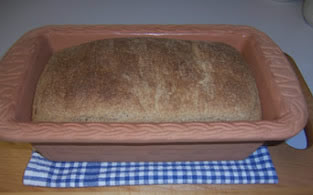
The bread is made in three stages. The first stage is to create a soaker. The second stage is making a preferment with either a biga or sourdough starter and the third and final stage is making the final dough.
I used a whole wheat starter to give the bread a more complex flavor. I baked it in a loaf pan so it could be used for sandwiches; however, you could also make a free form hearth bread and bake it on a baking sheet or stone.
Whole Wheat Bread using a Starter
Adapted from Peter Reinhart’s Whole Grain Breads
Makes: 1 large loaf
1st Stage: Create the Soaker
- 1 3/4 cups whole wheat flour (preferably fine grind, or a mix of fine and medium or course)
- 1/2 teaspoon salt
- 3/4 cup plus 2 tablespoons milk (scalded and cooled to room temperature – about 70°F/21°C), or soy milk, or rice milk
Using a large spoon, stir together all of the ingredients for about 1 minute, until all of the flour is hydrated and the ingredients form a ball of dough. If you prefer, you can also make this in a stand mixer with the paddle attachment, mixing on low speed for 1 minute.
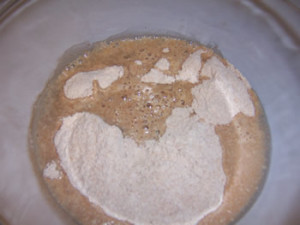 Mixing the ingredients for the soaker
Mixing the ingredients for the soaker
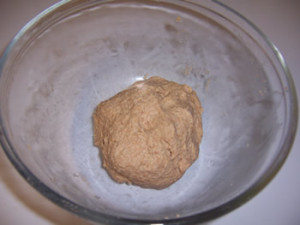 The soaker formed into a ball
The soaker formed into a ball
Cover the bowl with plastic wrap and leave at room temperature overnight or anywhere between 12 and 24 hours. (If it will be more than 24 hours until you mix the final dough, place the soaker in the refrigerator; it will be good for up to 3 days. Remove it 2 hours before mixing the final dough to take off the chill.)
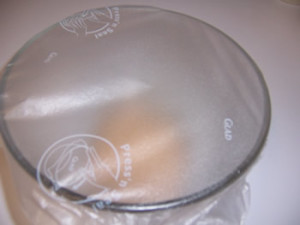
2nd Stage: Make the “wild yeast” starter (from the mother starter)I have a recently refreshed mother starter (the one I finished a few days ago) so I just took 14 ounces and used it in the final dough and then rebuilt the mother starter.
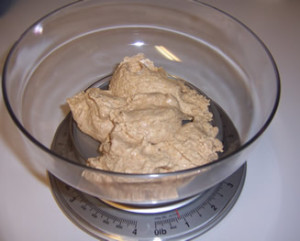
If you don’t have a recently refreshed starter, follow the process outlined below to create a “wild yeast” starter from a piece of the mother starter to create 14 ounces to use in the recipe.
Creating a Sourdough Starter from a piece of the Mother Starter
- 5 tablespoons mother starter
- 1 1/2 cups whole wheat flour, any grind
- 1/2 cup plus 2 tablespoons filtered or spring water, at room temperature (about 70°F/21°C)
Using a large spoon, combine all of the ingredients together in a bowl to form a ball of dough. You can do this by hand or use a stand mixer with the paddle attachment or dough hook. Using wet hands, knead the dough in the bowl for about 2 minutes to be sure all of the ingredients are evenly distributed and the flour is fully hydrated. The dough should feel very tacky. Let the dough rest for about 5 minutes, then knead it again with wet hands for 1 minute. The dough will become smoother but still be tacky.
Transfer the dough to a clean, lightly oiled bowl (oiling the bowl is optional). Cover the bowl loosely with plastic wrap and leave at room temperature for approximately 4 to 6 hours, until the dough is nearly double in size. The dough should have a pleasant aroma similar to apple cider vinegar. If the starter has not doubled or acidified properly, allow it to continue to develop at room temperature. It could take up to 8 hours or even longer, depending on conditions such as the ambient temperature or the strength of the original piece of starter, but 4 to 6 hours is typical.
When the starter has fully developed, knead it for a few seconds to degas it, return it to the bowl, cover the bowl tightly with plastic wrap, and refrigerate. The starter will be ready to use anytime, and it will be usable for 3 to 4 days.
3rd Stage: Create the final dough
- Use all of the soaker
- Use all (14 ounces) of the starter
- 7 tablespoons whole wheat flour, any grind
- 5/8 teaspoon salt
- 2 1/4 teaspoons instant yeast
- 2 1/4 tablespoons honey or
- 3 tablespoons sugar or brown sugar
- 2 tablespoons unsalted butter, melted or vegetable oil
- extra whole wheat flour for adjustments
Using a knife or metal pastry scraper, chop the soaker and the starter into 12 smaller pieces each (sprinkle some of the extra flour over the pre-doughs to keep the pieces from sticking back to each other).
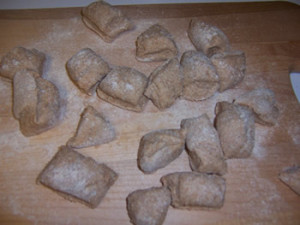
Combine the soaker and starter pieces in a bowl with all of the other ingredients (except the extra flour) and stir vigorously with a mixing spoon or knead with wet hands for about 2 minutes, until all of the ingredients are evenly distributed and integrated into the dough. The dough should be soft and slightly sticky, if not, add some of the extra flour or more water as needed.
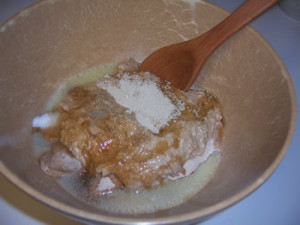
Dust your work surface with flour, then roll the dough in the flour to coat. Knead it by hand for 3 to 4 minutes. Incorporate only as much extra flour as needed. The dough should feel soft and tacky but not sticky. If the dough becomes too sticky to knead, dip your hands in a bowl of water (sticky dough will not stick to wet hands) and mist the work surface lightly with water to prevent sticking. Form the dough into a ball and let it rest on the work surface for 5 minutes while you prepare a clean, lightly oiled bowl.
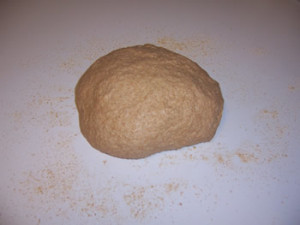
Anonymous says
Love your blog. Yet to try ur bread recipes. At present am trying the sourdough starter..hopefully will be done after 4-5 days.
Scinia
Cathy W. says
Hi, and thanks for visiting. So glad you like my blog. Let me know how the whole wheat starter turns out.
Anonymous says
Can you make this without using instant yeast in the final dough and substitute more of your starter instead?
Cathy W. says
Due to the weight of the whole wheat in the dough and the soaker, this bread benefits from a little yeast to give it a lift. However, feel free to use a little less yeast or experiment with just your sourdough starter to see how it performs. Just make sure it’s been recently fed and is active. I wouldn’t add any additional sourdough just the “wild yeast” starter created in step 2. Let me know how it goes.
Janet says
Ok really want to know why do you go through all of this work and then add instant yeast to make the final dough. Did I get it wrong or wasn’t the point of of all of this was replacing the yeast in conventional bread…
Cathy says
Hi Janet, this bread is based off of the bread in Peter Reinhart’s book Whole Grain Breads. The point of using this particular method in this specific bread wasn’t to replace the yeast, but to utilize a sourdough starter instead of the biga. Since this bread contains all whole wheat as well as a whole wheat soaker, the addition of the yeast gives it an extra boost. Also, at the time I made this loaf, my whole wheat starter was very young. If you have a mature starter, or just prefer not to add any dried yeast, feel free to omit it.